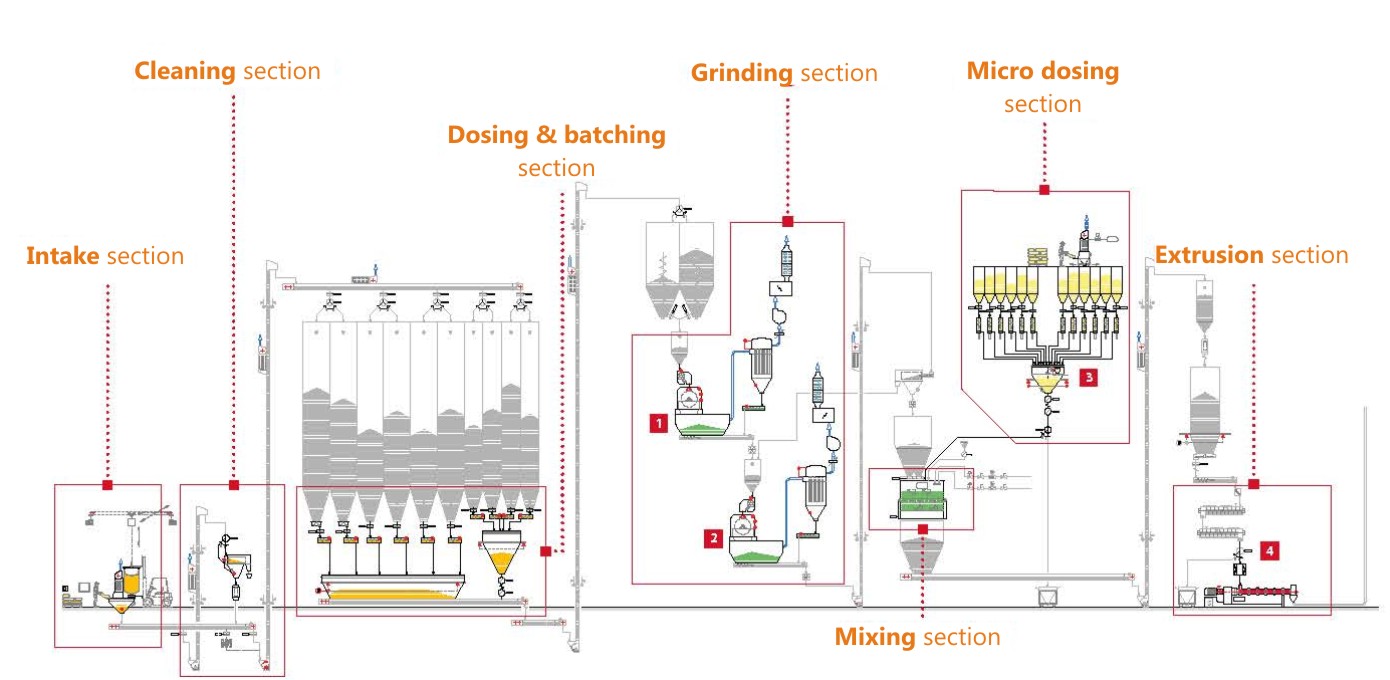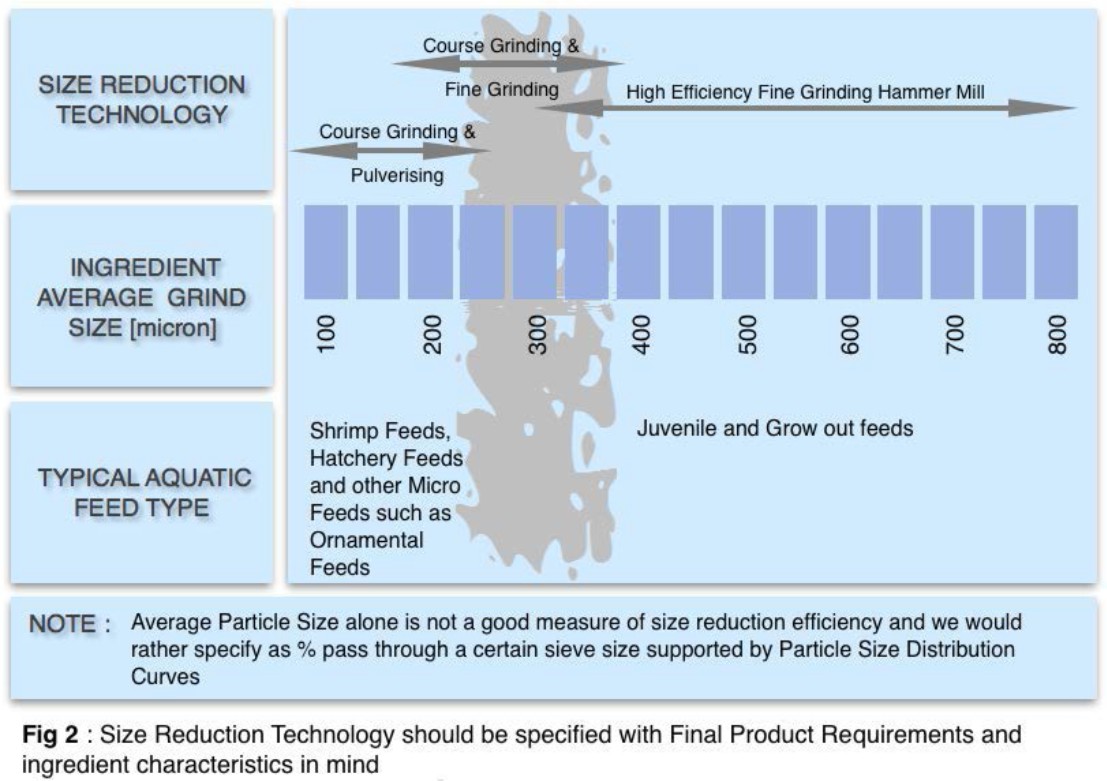Extrusion is the heart-beat of an aquatic feed processing plant. Still it largely depends on a well designed pre-extrusion and post-extrusion process to ensure the desired nutritional and physical outcome of the extruded final product. Knowledge and understanding of the raw materials, both dry and wet (or fresh) to be used in formulations, are of utmost importance in designing and specifying a process that will optimize extrusion performance. Pre-extrusion process design plays a key role in producing extruded aquatic feeds, which are safe and environmentally friendly.
Some critical pre-extrusion processing steps
It is difficult to accentuate only a few of the processing steps that make up a complete pre-extrusion process. Following are some pre-extrusion processes which are critical for getting the desired results:
Dry ingredient intake, cleaning and storage: The range of ingredients which are generally used for the manufacture modern-day aquatic feeds, are becoming increasingly more expensive. One should therefore take care as to how to acquire, accept, handle and store these ingredients on site. The following design criteria should be taken into consideration:
1. Intake sampling and quality control
2. Flexibility in intake & storage design allows for utilizing a wide range of raw ingredients
3. Good aspiration and dust removal from the intake pits
4. Cleaning of the raw ingredients and removing foreign plants and other materials including metals, sand and stones
5. Safe storage of raw ingredients in bulk storage silos, flat storage and dosing silos
Dry ingredient batching
Accurately combining ingredients together to create a proper formulation in order to achieve species health, species performance and production costs. All ingredients whether dry, liquid or fresh go through an accurate batching process ensuring that the final extruded product meets the species nutritional and lifecycle requirements. Process control and communicating formulation details between least cost formulation software and the field devices controlling the process play a key role in a successful feed mill design.
Size reduction
Size reduction is the first processing step where the physical and potentially nutritional characteristics of ingredients are changed. Physical ingredient size is reduced to an average particle size. Heat damage to the nutritional value of amino acids and some micro ingredients may take place when the size reduction system is not well designed or specified.
The traditional size reduction rule during extrusion is to have no particle larger than one third of the die openings in the extruder die plate. This is easily achievable using a single grinding step when producing larger extruded pellet sizes. It becomes a challenge when producing smaller pellets for shrimp and micro feed for hatcheries and ornamental fish.
Traditional hammer mill designs were in most cases inadequate for fine grinding in a single step. It was and still is common to use a course grinding hammer mill followed by a fine grinding hammer mill to achieve the required fine grinding specifications. For ultra-fine grinding, to achieve an average particle size below 300 micron, a course grinding hammer mill is used in conjunction with a pulverizer. This is a common setup for producing shrimp feed and micro feed for hatcheries or ornamental fish.A range of high efficiency hammer mills are now available in the market, capable of producing narrow particle size distribution curves with average particle size down to the 300-350 micron mark. The design of these hammer mills allow for shorter grinding chamber retention times and therefore lower grinding temperatures. Coupled with a variable frequency drive and special features in terms of breaker plate design and sieve types, these hammer mills can mill a large range of cereals and other aquatic feed ingredients at lower cost compared to traditional systems. Figure 2 shows typical application range for size reduction technology in relation to average ingredient size and feed type requirements.


More critical pre-extrusion processes
Other pre-extrusion processing steps of critical importance are:
1. Mixing: a range of single shaft ribbon mixers, single and twin shaft paddle mixers are on the market. The ultimate goal is to deliver a homogeneous mix to the extruder surge bin, representing the specific formulation to be extruded. A well-designed mixing environment makes provision for additional liquids and dry ingredients as well.
2. Vitamins & minerals addition: it is common for large feed mills to have dedicated micro ingredient dosing sections. Such capability provides more control and could limit costs when compared to pre-packed vitamins and minerals.
3. Fresh ingredient intake & preparation: the demand to include fresh meat, fish and other wet by-products into the formulations of aquatic species is increasing. Great care should be taken to ensure ingredient streams do not cause cross-contamination hazards. Keeping dry, fresh and final product separated. Fresh products could be pre-processed into slurries, hydrolysates, concentrates and other forms prior to inclusion into the feedstock stream.
Critical process design aspects
A range of operations make up the pre-extrusion process. The discussion in this article covered some aspects of the more important operations. Ultimately the process has to be engineered into a three dimensional space that will meet operational requirements and other feed milling aspects that are frequently overlooked:
1. Feed plant zoning in line with functional and feed-safety requirements Ultimately the pre-extrusion process should supply meal to the extruder that will allow the extrusion operation to be consistent, constant and easily controllable. This indeed, is a cost efficient and reliable way.
2. Layout design and transitional equipment sections that will minimize cross contamination and segregation of mixed formulations
3. A safe environment for workers
4. Dust and odor control
5. Sound insulation
by Paul Eijmberts, Ottevanger













